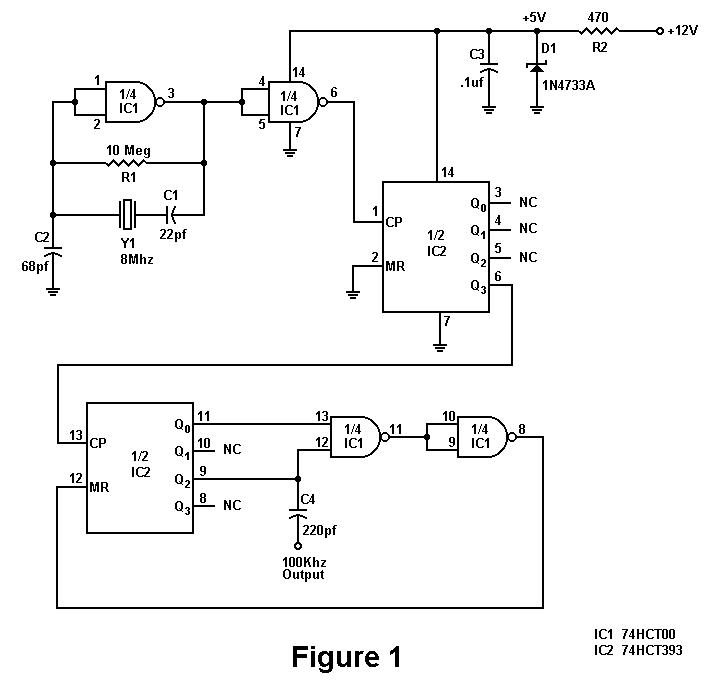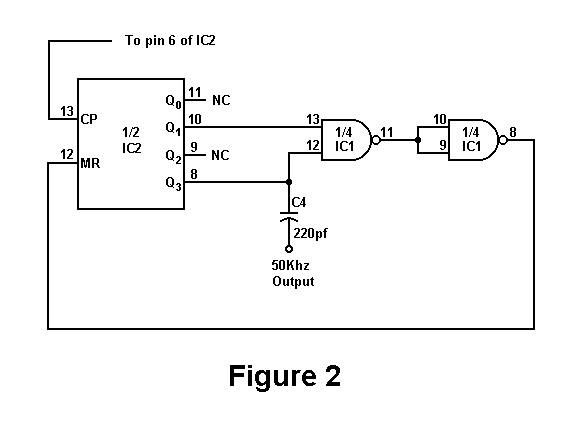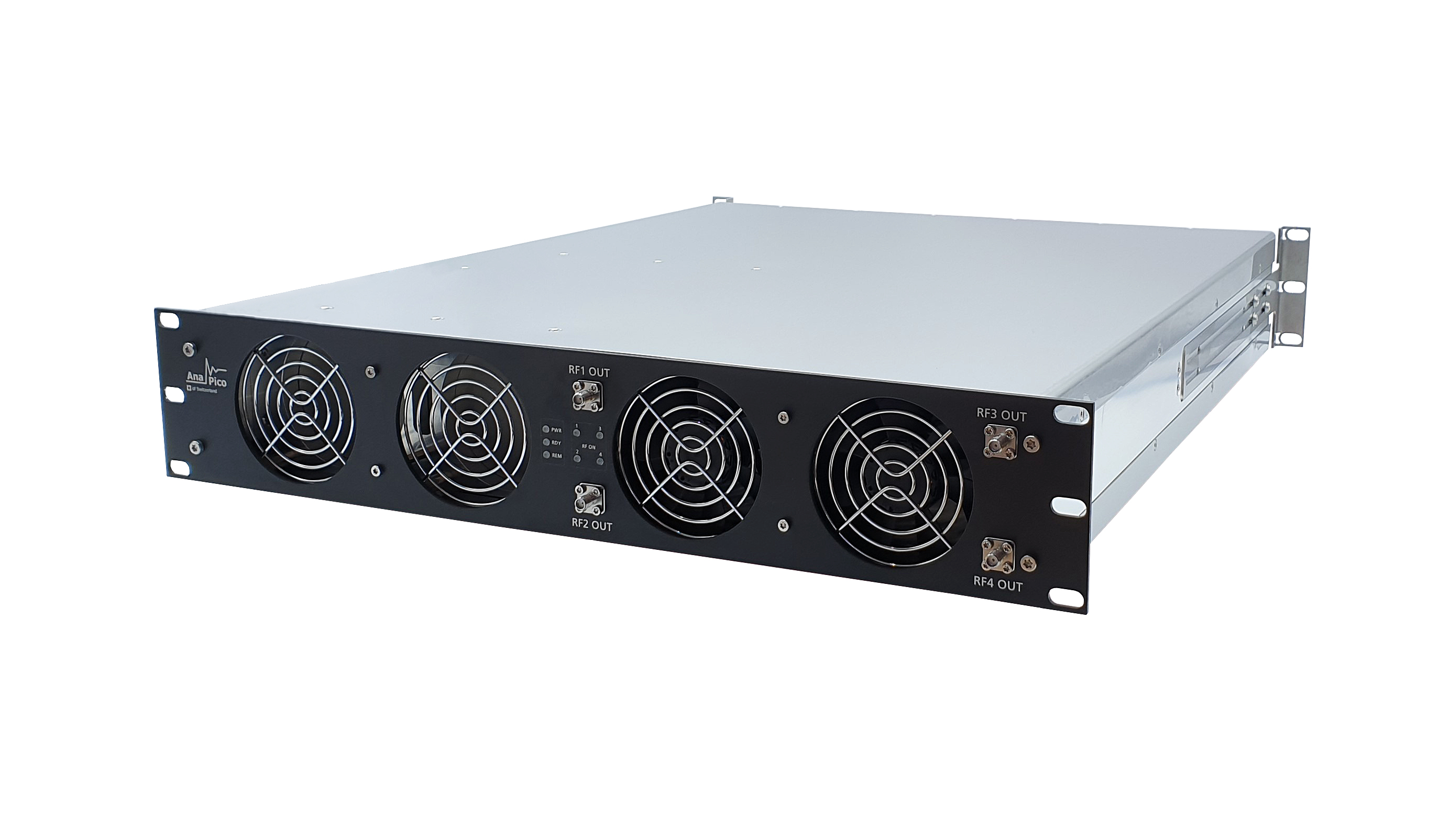高穩(wěn)定100KHz時鐘發(fā)生電路,100khz clock generator
關鍵字:高穩(wěn)定100KHz時鐘發(fā)生電路
Build A 100Khz Crystal Calibrator
By N1HFX
There is a great deal of old amateur gear which many amateurs have decided to restore and bring back to life. While much of the early amateur transceivers work just fine they usually lack a digital readout and must rely on analog dials for tuning. The problem of dial calibration is complicated by the non-linear effects of tuning capacitors. This month's circuit is a 100Khz crystal calibrator using an inexpensive microprocessor crystal and CMOS IC's which are readily available at Radio Shack.
The main problem with building a 100Khz oscillator is the unavailability of 100Khz crystals. Even if you find a vendor willing to cut such a crystal for you, plan on paying $20 or more not including shipping charges. The circuit in Figure 1 uses an inexpensive 8Mhz microprocessor crystal which can be easily obtained from most parts suppliers for about $1. Using a 74HCT393 binary counter IC, we can easily divide down the 8 MHz signal from our crystal into 100Khz or almost any frequency we need.
The circuit in Figure 1 uses a couple of NAND gates (74HCT00 IC) for our 8Mhz crystal oscillator. Capacitor C2 actually helps us tune the crystal to the exact frequency, Use any value of C2 from about 22pf to about 82pf to get the oscillator on frequency. In the prototype, 68pf worked fine for most of the crystals tested. For an exact frequency, replace C2 with a 22pf and add a 50pf trimmer capacitor in parallel. By adjusting the 50pf trimmer capacitor, we can easily get the crystal exactly on frequency. The first NAND gate is our oscillator while the second NAND gate acts as a buffer and conditions the signal. This signal is then fed into the clock pulse input of one of the 4 bit binary counters in IC2. By taking the output from the Q3 signal, we have now divided the signal by 16 giving us 500Khz. This signal is now fed into the clock pulse input of the second 4 bit binary counter. In the first counter we tied the MR (clock reset) line to ground. In the second counter, we need the count to reset when we reach a binary five, which will allow us to divide the 500Khz by 5. For this counter, we used the last 2 remaining NAND gates in IC1 to detect the desired value. When we reach the correct reset interval, the MR line goes high resetting the counter to zero and allowing us to effectively divide by 5. The 100Khz output is taken from the Q2 line and is coupled through capacitor C4.
If you prefer, this circuit can be easily changed to a 50Khz calibrator by wiring pins 13 & 14 of IC1 into pins 10 and 8 of IC2. See Figure 2 for details. This arrangement makes the second counter reset at binary 10 which divides the 500Khz by 10 giving us the desired 50Khz.
The HCT series CMOS logic IC's require a 5 volt power supply just like the old TTL logic series. In this circuit we used a 5 volt zener diode, D1, along with resistor R2 to get 12 volts down to 5 volts. Capacitor C3 is used primarily for bypassing the oscillator and must be used in this circuit. If you prefer to power this circuit from a 9 volt battery, then reduce resistor R2 to 220 ohms for best performance.
If you plan to install this circuit inside a transceiver, feed the output directly to the receiver front end. Make certain you have connected it after the TR relay so that the circuit doesn't get zapped by RF from the transmitter side. Also, you will want to install an ON/OFF switch which will interrupt the 12V line going to the circuit. As with all static sensitive CMOS IC's, use special handling precautions and do not leave out those IC sockets.
This circuit has been found to generate accurate birdies at every 100Khz and will be an excellent aid in getting that old rig right on frequency. The accuracy of the 100Khz birdies will depend on how close the 8Mhz oscillator is on frequency. With the difficulty in getting crystals for specific frequencies, this circuit gives new meaning to the words "Divide and Conquer".
要產生100千赫茲頻率的電路,如果采用晶體管搭建的LC震蕩電路,當要求頻率很穩(wěn)定時比較困難,而采用晶體震蕩器則容易實現(xiàn),而低頻率的晶體震蕩器又不容易獲得,下面的電路就能夠將頻率較高的晶體震蕩器通過適當?shù)碾娐份敵鲱l率較低的信號。
電路原理簡單,通過IC1的門電路,晶體以及外圍電路組成8M赫茲震蕩器,通過IC2分頻獲得100千赫茲信號。
DE N1HFX
下圖是產生50千赫茲的電路,13腳接上圖的IC2的6腳就可以了。
元件清單
Parts List
| C1
聲明:本文內容及配圖由入駐作者撰寫或者入駐合作網(wǎng)站授權轉載。文章觀點僅代表作者本人,不代表電子發(fā)燒友網(wǎng)立場。文章及其配圖僅供工程師學習之用,如有內容侵權或者其他違規(guī)問題,請聯(lián)系本站處理。
舉報投訴
發(fā)布評論請先 登錄 相關推薦 ads8681標稱1mHz的采樣率,如果要采樣100khz的信號,是否可以正確采樣,能否旁路低通濾波器?
請問,ads8681標稱1mHz的采樣率,但是有個低通濾波器,似乎只能猜到15khz以下的信號,請問如果要采樣100khz的信號,是否可以正確采樣,能否旁路低通濾波器,謝謝
發(fā)表于 12-30 06:47
請問DS90UB903Q的IIC工作頻率必須為100KHz嗎?
問題:DS90UB903Q的IIC工作頻率必須為100KHz嗎?
問題發(fā)生條件:芯片配置:DS90UB903Q的工作電壓為1.8V,VCCIO為3.3V;MODE=1,PDB=1;Rid=0ohm
發(fā)表于 12-26 07:08
需要1k~100kHZ可調的正弦波,電壓也可調,有推薦的芯片嗎?
需要1k~100kHZ可調的正弦波, 電壓也可調, 有推薦的芯片嘛? DAC8532是否可以呢
發(fā)表于 12-13 07:19
想要測量100KHZ的正弦波的幅值,用ADS1258可以嗎?
我想要測量100KHZ的正弦波的幅值,用ADS1258可以嗎?是需要先轉換成直流然后進行測試嗎? 有沒有相關的案例,謝謝
發(fā)表于 12-13 06:01
AFE5818EVM采集100KHz左右方波信號,采集數(shù)據(jù)不準確的原因?怎么解決?
問題:1)輸入100KHz方波信號,脈沖組(含50個方波),Vpp=100mV,占空比可調,不同占空比時,使用TSW1400采集信號的電壓幅值不同,不知道原因?
2)同時方波信號還伴有爬坡過程
發(fā)表于 11-25 07:32
求助,有適合100kHz~500kHz的集成放大器芯片嗎?
如題,Ti 有適合100kHz~500kHz 的集成放大器芯片嗎?功率不超過50w,單電源供電的。
目前看到的絕大部分是音頻功放。
發(fā)表于 10-16 07:34
INA128對100kHz 2mV的100倍放大,怎么達不到?
在輸入信號為100kHz 2mV時,選用的電阻為505.1Ω,設計增益為100,但仿真出來的結果是181mV,增益為90.5。可是INA128的增益帶寬積在G=100時,可達到200kHz
發(fā)表于 09-20 08:28
OPA564-Q1從20kHz~100kHz這個頻段的THD+N指標是多少呢?OPA564-Q1的信號頻率范圍是1k~100kHz,輸入電壓峰值10v(即峰峰值+-10v,其中DAC為20位,最大支持+-15v的電壓峰峰值輸出);OPA564-Q1的輸出負載為感性負載(直流電阻4歐,電感
發(fā)表于 09-13 07:45
TLV3501輸入的正弦超過100KHz輸出的方波就會出現(xiàn)失真,怎么解決?按照技術手冊做的一個過零比較器,但是輸入的正弦(峰峰值2V)超過100KHz輸出的方波就會出現(xiàn)失真?怎么辦。
發(fā)表于 08-26 07:29
OPA365芯片明明增益帶寬50MHz,為什么噪聲密度曲線只到100KHz,后面頻率就沒了呢?
諸位大牛好!我想請教下,TI的OPA365芯片明明增益帶寬50MHz,但為什么噪聲密度曲線只到100KHz,后面頻率就沒了呢?
如果想知道其工作在500KHz的噪聲密度怎么辦?謝謝諸位解答!!!祝心情愉快~
發(fā)表于 08-21 07:33
OPA2333積分電路100k頻率不放大是怎么回事?
圖一20mv 50hz正常放大;圖二20mv 100khz放大信號過小。有什么辦法可以100khz放大20mv到1V
發(fā)表于 08-05 08:00
LF353運放輸入20khz的正弦波,低通濾波截止頻率100khz后有相位差如何解決?
運放輸入20khz的正弦波,低通濾波截止頻率100khz后有相位差,有啥辦法解決嗎
發(fā)表于 07-31 06:00
使用CX3為EVAL_PASCO2_SENSOR添加寄存器,i2c運行頻率如何設置為100kHz? 并為我的圖像EVAL_PASCO2_SENSOR添加寄存器。 i2c默認運行頻率為 400kHz,如何將其設置為 100kHz?
發(fā)表于 03-06 06:50
AnaPico多通道矢量信號源100KHz至40GHzAPVSGXX-X 系列是高速切換APVSG系列矢量信號發(fā)生器的多通道版本,覆蓋從 100 kHz 到 4、6、12、20 或 40 GHz 的連續(xù)頻率范圍。可實現(xiàn)出色的超快的相位同步和相參輸出的頻率掃描、啁啾、脈沖內調制、脈沖

|




 高穩(wěn)定100KHz時鐘發(fā)生電路,100khz clock generator
高穩(wěn)定100KHz時鐘發(fā)生電路,100khz clock generator










評論